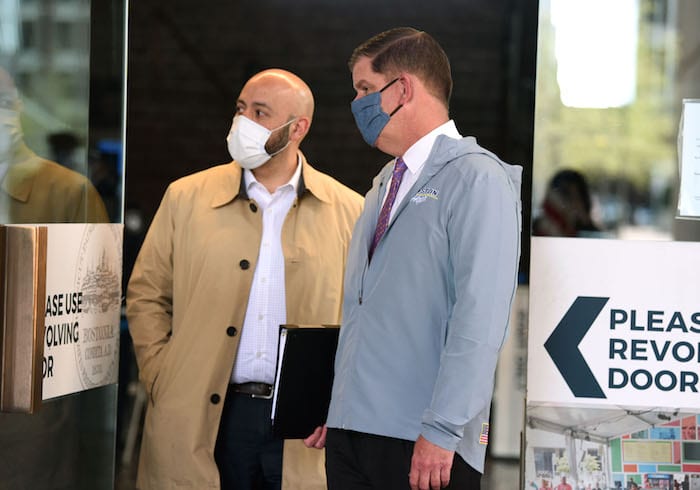
HHS chief details battle against COVID in Boston.
It has been a challenging year for Marty Martinez, the chief of Health and Human Services. His is the largest government agency in the city of Boston, where the current nightmares include having to socially distance 50,000-plus public school students on top of having more than 20 coronavirus testing locations run by community health centers, as well as mobile operations in various communities interacting with the CARES Act and the Boston Resiliency Fund. The chief is in the middle of it all.
While the fight against COVID-19 is a 24/7 undertaking, Martinez took some time to answer questions from DigBoston, including about his relationship with Mayor Marty Walsh, how the pandemic has impacted Black and Latinx populations, and why you probably won’t see the kind of tensions between Boston City Hall and its health department that erupted between New York City Mayor Bill de Blasio and his now-former Commissioner of Health Oxiris Barbot.
The topics we discussed are in bold italics, with Martinez’s responses following.
Where things stand
In the City of Boston, we’re talking about a time frame where we saw our peak in mid-to-late April, a steady climb up to mid-to-late April. … In most of the late spring into summer, there’s been a decline in activity—less cases, less hospitalizations, lower positives in terms of test rate.
The news isn’t all good, though
Two weeks or so [ago], we’ve started to see a small uptick in the case numbers in Boston, as well as across the state. … Bostonians have been very good at following guidelines, wearing face coverings, socially distancing themselves. We’re really all in it together. Of course, there’s a little bit of an uptick. We’re monitoring it closely.
Boston’s hardest-hit neighborhoods and demographics
COVID-19 has disproportionately impacted Black and brown Bostonians. [Martinez listed key statistics: Blacks represent between 24 and 25% of the city’s population but around 37% of its cumulative COVID-19 cases. And while the Latinx population represents 19% of the city total, it reflects 28% of its COVID-19 cases.] We’ve seen Blacks/African Americans and Latinos disproportionately impacted in testing positive for COVID-19 over the entire course of the pandemic in Boston. … [There’s] been a higher increase in young people, under age 39, testing positive, at a much higher rate than in the early days.
[Among the 23 Boston neighborhoods], we’ve seen spikes in East Boston, Hyde Park, Mattapan in terms of testing, testing positive, positive testing rate over the course of the pandemic. [A] “high positive rate” [continues in Dorchester], and we’re seeing it lately in South Boston.
Public and private resources
We’re able to lift our testing, our mobile testing, which is important. … Neighborhoods with higher testing-positive rates have had lower amounts of testing. CARES Act money has helped with funding and research.
There are people needing access to food, rental support, small business [support]. … The spread of COVID-19 has slowed down all of these things, closed businesses. … City resources support organizations [and] individuals impacted [by] COVID-19.
The Boston Resiliency Fund … has administered around $24 million out, given to nonprofits, health centers, a variety of different organizations, for the needs of Bostonians. … It’s important that public dollars and private dollars have a concentrated effort and plan on containing COVID-19 and the impact of inequality.
How Boston compares
Boston is not one of the most impacted by population. I’m proud of the fact that Boston is really locked-in on social distancing measures, locked-in to face coverings, protecting each other.
Help from the city, state, and (sometimes) Washington
We correspond and work with [Mayor Walsh and his own team at City Hall] daily, making decisions, putting protocols in place, everything necessary to keep the city safe. [Gov. Charlie Baker and Marylou Sudders, Massachusetts secretary of Health and Human Services, make] “sure we work step by step, hand in hand on decisions that are best for Massachusetts.” [Martinez said the federal government “has been helpful in some ways with additional resources,” but criticized the Trump administration for what he described as inconsistent messaging on “what it takes to keep people safe.”]
Mayoral dustups
Until less than a month ago, we had daily calls seven days a week between the mayor and his staff, myself, the public health department, and many other city officials and leaders. … We tackled COVID-19, [figuring out] what was our strategy. [Walsh] has let science and data lead us. It’s central to making strategies for the problem. He’s made difficult decisions like closing schools, canceling the Boston Marathon in partnership with the Boston Athletic Association and the state. He’s done it with science and public health at the forefront.
What we’ve done in this city, the mayor has been proactive from the beginning, and the BPHC, since the beginning of January, has been working with COVID-19 before anybody knew what COVID-19 was or the social distancing perspective. It’s great to have the support and partnering. We have not had other challenges that exist in other cities.
Amplifying the Latinx community
It was great to see [the recent Amplify Latinx virtual conference] sort of lift up and amplify this issue with so many folks present. [Martinez spoke on a panel about the pandemic at the event.] For me, personally, it’s good to see individuals and leaders come together and pursue the issue. … We’ve tackled it through Amplify Latinx and the Greater Boston Latino Network, different organizations, and health centers. It’s good to see advocates come together. Recently, the Boston Resiliency Fund has given back to the Latino network and other community health centers, committing resources to community outreach messaging. [What’s] in the messaging, cultural competency messaging, is important. It can’t just be a hashtag or a video on Twitter.
Challenges beyond COVID-19
Last year, we had a tough flu season, one of our more challenging ones. Now you think about further [on], the flu and COVID-19 resemble each other so much. … Who will set up flu clinics in office buildings that are closed? It looks like we will not be able to do it in the same way. We still need people to get the flu shot. It’s even more important. … The challenge we’re working on now is that flu season is in front of us.
Drawing on support
I have family and friends all over the country. … They’re experiencing it differently—my family in Texas or Nebraska or California. It’s different in different places … In terms of time, in March and April, when many of them were not [affected], they were worried about what was happening in Boston. It was tough. In my own home, me and my husband, I really think we have taken care of each other’s physical health, mental health. The pandemic has had long-term difficulties and different challenges for myself and our city. …
I’m proud of what we do, supporting others to get through this.
Rich Tenorio is a writer and editor whose work has appeared in international, national, regional and local media outlets. He is a graduate of Harvard College and the Columbia University Graduate School of Journalism. He is also a cartoonist.

